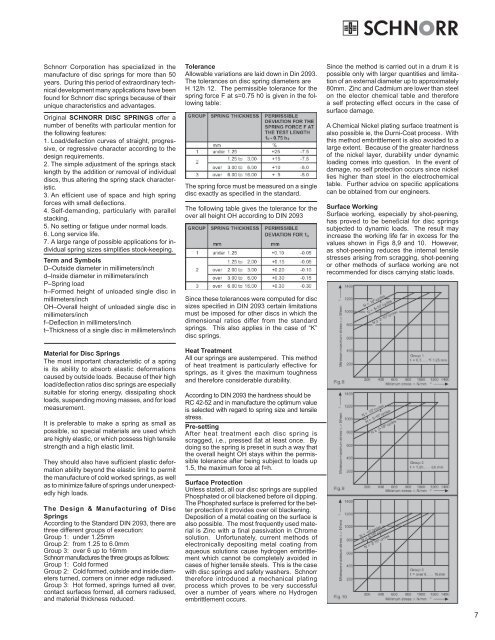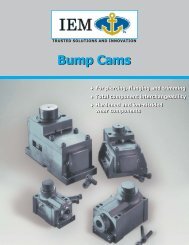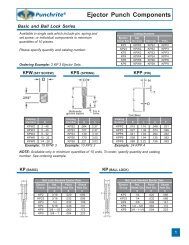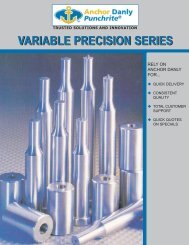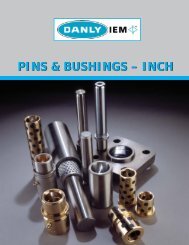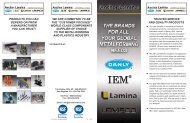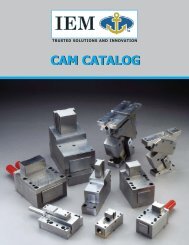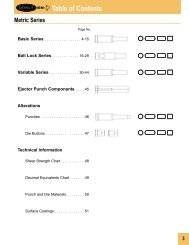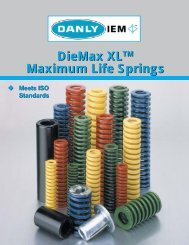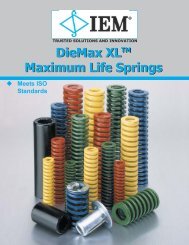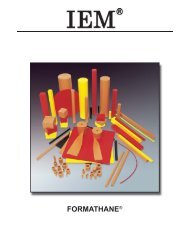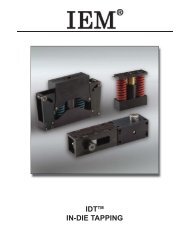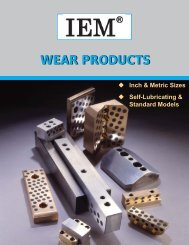You also want an ePaper? Increase the reach of your titles
YUMPU automatically turns print PDFs into web optimized ePapers that Google loves.
Schnorr Corporation has specialized in the<br />
manufacture of disc springs for more than 50<br />
years. During this period of extraordinary technical<br />
development many applications have been<br />
found for Schnorr disc springs because of their<br />
unique characteristics and advantages.<br />
Original SCHNORR DISC SPRINGS offer a<br />
number of benefi ts with particular mention for<br />
the following features:<br />
1. Load/defl ection curves of straight, progressive,<br />
or regressive character according to the<br />
design requirements.<br />
2. The simple adjustment of the springs stack<br />
length by the addition or removal of individual<br />
discs, thus altering the spring stack characteristic.<br />
3. An effi cient use of space and high spring<br />
forces with small defl ections.<br />
4. Self-demanding, particularly with parallel<br />
stacking.<br />
5. No setting or fatigue under normal loads.<br />
6. Long service life.<br />
7. A large range of possible applications for individual<br />
spring sizes simplifi es stock-keeping.<br />
Term and Symbols<br />
D–Outside diameter in millimeters/inch<br />
d–Inside diameter in millimeters/inch<br />
P–Spring load<br />
h–Formed height of unloaded single disc in<br />
millimeters/inch<br />
OH–Overall height of unloaded single disc in<br />
millimeters/inch<br />
f–Defl ection in millimeters/inch<br />
t–Thickness of a single disc in millimeters/inch<br />
Material for Disc <strong>Springs</strong><br />
The most important characteristic of a spring<br />
is its ability to absorb elastic deformations<br />
caused by outside loads. Because of their high<br />
load/deflection ratios disc springs are especially<br />
suitable for storing energy, dissipating shock<br />
loads, suspending moving masses, and for load<br />
measurement.<br />
It is preferable to make a spring as small as<br />
possible, so special materials are used which<br />
are highly elastic, or which possess high tensile<br />
strength and a high elastic limit.<br />
They should also have suffi cient plastic deformation<br />
ability beyond the elastic limit to permit<br />
the manufacture of cold worked springs, as well<br />
as to minimize failure of springs under unexpectedly<br />
high loads.<br />
The Design & Manufacturing of Disc<br />
<strong>Springs</strong><br />
According to the Standard DIN 2093, there are<br />
three different groups of execution:<br />
Group 1: under 1.25mm<br />
Group 2: from 1.25 to 6.0mm<br />
Group 3: over 6 up to 16mm<br />
Schnorr manufactures the three groups as follows:<br />
Group 1: Cold formed<br />
Group 2: Cold formed, outside and inside diameters<br />
turned, corners on inner edge radiused.<br />
Group 3: Hot formed, springs turned all over,<br />
contact surfaces formed, all corners radiused,<br />
and material thickness reduced.<br />
Tolerance<br />
Allowable variations are laid down in Din 2093.<br />
The tolerances on disc spring diameters are<br />
H 12/h 12. The permissible tolerance for the<br />
spring force F at s=0.75 h0 is given in the following<br />
table:<br />
The spring force must be measured on a single<br />
disc exactly as specifi ed in the standard.<br />
The following table gives the tolerance for the<br />
over all height OH according to DIN 2093<br />
Since these tolerances were computed for disc<br />
sizes specifi ed in DIN 2093 certain limitations<br />
must be imposed for other discs in which the<br />
dimensional ratios differ from the standard<br />
springs. This also applies in the case of “K”<br />
disc springs.<br />
Heat Treatment<br />
All our springs are austempered. This method<br />
of heat treatment is particularly effective for<br />
springs, as it gives the maximum toughness<br />
and therefore considerable durability.<br />
According to DIN 2093 the hardness should be<br />
RC 42-52 and in manufacture the optimum value<br />
is selected with regard to spring size and tensile<br />
stress.<br />
Pre-setting<br />
After heat treatment each disc spring is<br />
scragged, i.e., pressed fl at at least once. By<br />
doing so the spring is preset in such a way that<br />
the overall height OH stays within the permissible<br />
tolerance after being subject to loads up<br />
1.5, the maximum force at f=h.<br />
Surface Protection<br />
Unless stated, all our disc springs are supplied<br />
Phosphated or oil blackened before oil dipping.<br />
The Phosphated surface is preferred for the better<br />
protection it provides over oil blackening.<br />
Deposition of a metal coating on the surface is<br />
also possible. The most frequently used material<br />
is Zinc with a fi nal passivation in Chrome<br />
solution. Unfortunately, current methods of<br />
electronically depositing metal coating from<br />
aqueous solutions cause hydrogen embrittlement<br />
which cannot be completely avoided in<br />
cases of higher tensile steels. This is the case<br />
with disc springs and safety washers. Schnorr<br />
therefore introduced a mechanical plating<br />
process which proves to be very successful<br />
over a number of years where no Hydrogen<br />
embrittlement occurs.<br />
Since the method is carried out in a drum it is<br />
possible only with larger quantities and limitation<br />
of an external diameter up to approximately<br />
80mm. Zinc and Cadmium are lower than steel<br />
on the elector chemical table and therefore<br />
a self protecting effect occurs in the case of<br />
surface damage.<br />
A Chemical Nickel plating surface treatment is<br />
also possible ie, the Durni-Coat process. With<br />
this method embrittlement is also avoided to a<br />
large extent. Because of the greater hardness<br />
of the nickel layer, durability under dynamic<br />
loading comes into question. In the event of<br />
damage, no self protection occurs since nickel<br />
lies higher than steel in the electrochemical<br />
table. Further advice on specifi c applications<br />
can be obtained from our engineers.<br />
Surface Working<br />
Surface working, especially by shot-peening,<br />
has proved to be benefi cial for disc springs<br />
subjected to dynamic loads. The result may<br />
increase the working life far in excess for the<br />
values shown in Figs 8,9 and 10. However,<br />
as shot-peening reduces the internal tensile<br />
stresses arising from scragging, shot-peening<br />
or other methods of surface working are not<br />
recommended for discs carrying static loads.<br />
7


